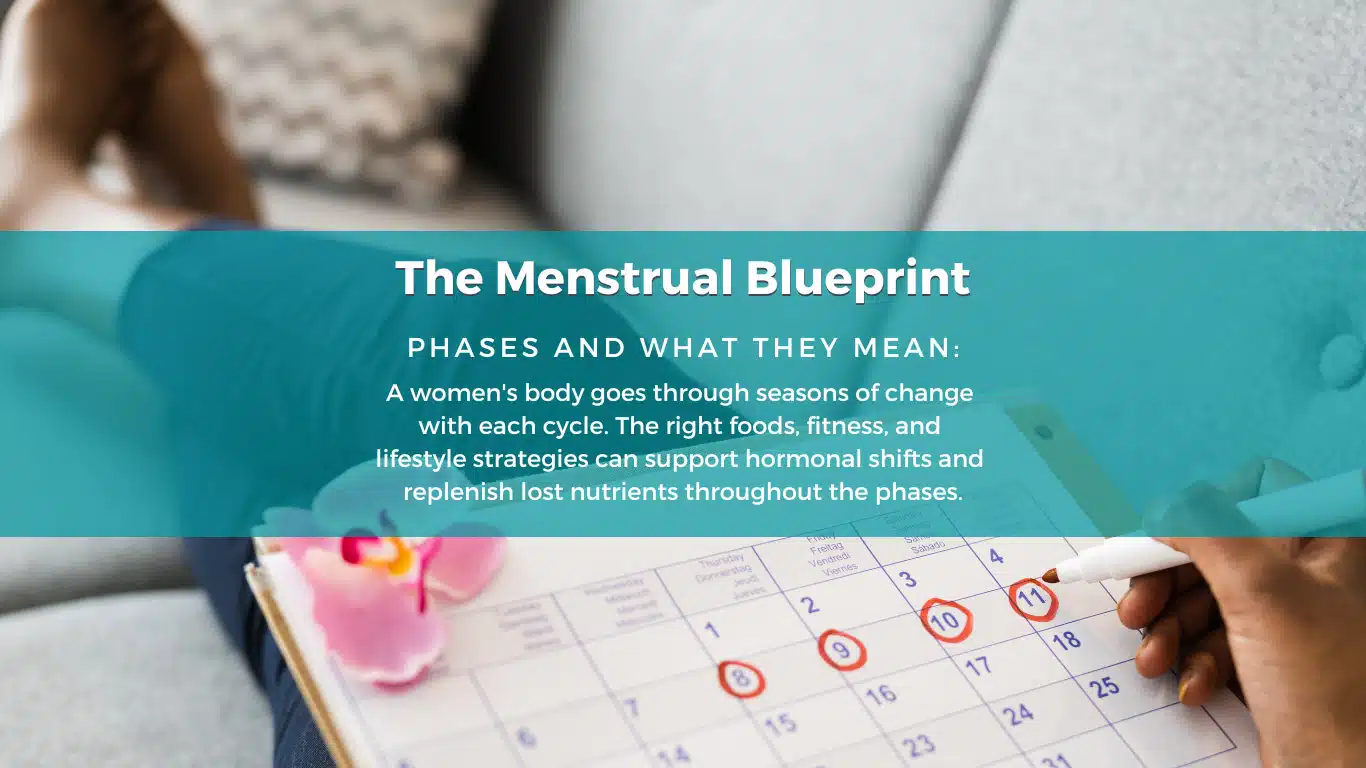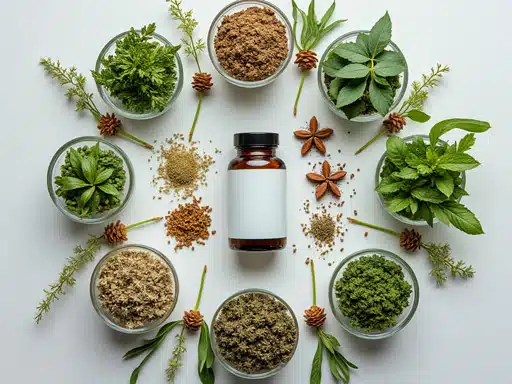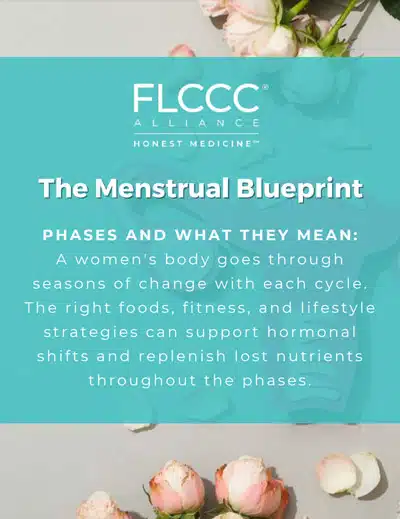Explore the phases of the menstrual cycle, from menstruation to ovulation and the luteal phase. Understand how hormones shape your 28-day reproductive journey.

For many women, the menstrual cycle feels like an unpredictable force, sometimes causing discomfort, fatigue, or emotional ups and downs. Yet, beneath the surface, your body follows a natural rhythm. Each phase of your menstrual cycle brings distinct changes, from mood shifts to energy dips, all guided by your hormones.
However, many women go through these phases without fully understanding them. The good news? By tuning into these hormonal changes and syncing your lifestyle accordingly, you can enhance your overall well-being and take control of your health.
We’re thrilled to present the second guide in our series on #WomensHealth! This ‘Menstrual Blueprint’ explores the menstrual cycle and offers insights on foods, supplements, and lifestyle strategies to support hormonal changes and replenish essential nutrients throughout each… pic.twitter.com/wbH7tHBIPt
— FLCCC Alliance (@Honest_Medicine) September 13, 2024
This guide will take you through the four phases of the menstrual cycle and show you how to align your diet, exercise, and self-care to each stage. Plus, you’ll learn how to track your cycle and make informed decisions for your health. If you’re ready to dig deeper into this topic, Dr. Kristina Carman’s comprehensive guide has tons of info, plus easy, actionable steps for better menstrual health.
Get started by downloading the guide below, or keep scrolling for a summary of what’s inside.
1. The Menstrual Phase: What Happens During the Menstrual Phase?
During the menstrual phase, which typically lasts 3-7 days, the uterus sheds its lining. Hormone levels, including estrogen and progesterone, are at their lowest during this time, leading many women to feel tired and introspective.
How Long Does a Normal Period Last?
A normal period lasts between 3 to 7 days. However, periods can vary based on several factors such as stress, diet, and exercise.
Foods to Focus on During the Menstrual Phase
Replenishing nutrients lost during menstruation is key. Focus on iron-rich foods like spinach, lentils, and pumpkin seeds. Pair these with Vitamin C-rich foods like citrus fruits and berries to help absorb the iron. Antioxidant foods, such as blueberries and dark leafy greens, can also help reduce inflammation and support overall health.

2. The Follicular Phase: How Do You Feel During the Follicular Phase?
The follicular phase starts on the first day of your period and lasts until ovulation (days 6-14). During this phase, the body prepares for the possibility of pregnancy by rebuilding the uterine lining and developing a mature follicle.
Women often feel more energetic, optimistic, and creative during this phase due to rising estrogen levels. It’s a great time for tackling new projects, trying new workouts, or engaging in social activities.
Foods to Eat During the Follicular Phase
In the follicular phase, your body benefits from estrogen-balancing foods such as flaxseeds, broccoli, and arugula. High-quality protein sources like wild-caught fish and pasture-raised eggs are also important for rebuilding tissues and preparing for ovulation.
3. The Ovulatory Phase: What Happens During Ovulation?
The ovulatory phase occurs around day 14 and lasts 24-48 hours. During this phase, a mature egg is released from the ovary, and the body prepares for possible fertilization. Women are most fertile during this time.
What Are the Signs of Ovulation?
Common signs of ovulation include increased cervical mucus, heightened libido, and a slight increase in basal body temperature. Many women also report feeling more energetic and social during this phase due to the peak in estrogen and luteinizing hormone.
Foods to Eat During the Ovulatory Phase
During ovulation, focus on anti-inflammatory foods like omega-3-rich fish (salmon, sardines) and antioxidant-rich fruits (berries, cantaloupe). These foods help reduce inflammation and support the body’s hormonal changes.

4. The Luteal Phase: Why Do I Feel Tired During the Luteal Phase?
The luteal phase lasts from day 17 until the start of your next period (days 17-28). After ovulation, progesterone levels rise, preparing the body for a possible pregnancy. If pregnancy does not occur, hormone levels drop, leading to premenstrual symptoms like fatigue, mood swings, and bloating.
How Can I Manage Mood Swings During the Luteal Phase?
Many women experience mood swings and irritability during the luteal phase due to hormonal fluctuations. Incorporating magnesium-rich foods like spinach, almonds, and dark chocolate can help stabilize mood. Regular, moderate exercise like yoga or walking can also improve mood and reduce bloating.
Foods to Eat During the Luteal Phase
Complex carbohydrates like sweet potatoes, quinoa, and whole grains help regulate blood sugar levels and keep energy stable during this phase. Foods rich in antioxidants, such as carrots, avocado, and beets, can also support the body’s hormonal balance.
Menstruation FAQs
Do you have a normal menstrual cycle? Your cycle length can vary depending on a variety of factors. Here are some frequently asked questions to help you assess at all stages of the menstrual cycle.
- How Do I Track My Menstrual Cycle?
- What Is Considered an Irregular Period?
- How Does Your Period Change Over Time?
- How Do I Know What Phase of the Menstrual Cycle I Am In?

1. How Do I Track My Menstrual Cycle?
Tracking your menstrual cycle helps you understand your body’s rhythms and plan accordingly. You can track your cycle using a period tracking app or a calendar. Here are some key things to note:
- First day of your period: This marks the start of your cycle.
- Ovulation: Pay attention to changes in cervical mucus and body temperature, as these can signal ovulation.
- Length of the cycle: A typical cycle lasts 28 days, but cycles can vary from 21 to 35 days.
By tracking your cycle, you can better anticipate physical and emotional changes and take steps to support your health during each phase.
2. What Is Considered an Irregular Period?
An irregular period is one that does not follow a consistent cycle. While the average menstrual cycle is 28 days, it’s normal for some women to have shorter or longer cycles. However, if your cycle is consistently shorter than 21 days or longer than 35 days, or if you skip periods frequently, you may want to consult a healthcare provider.
3. How Does Your Period Change Over Time?
As women age, their menstrual cycles may change. Hormonal shifts due to factors like stress, pregnancy, and perimenopause can cause cycles to become irregular or change in length. Understanding these changes helps you stay in tune with your body and anticipate any potential health concerns.
4. How Do I Know What Phase of the Menstrual Cycle I Am In?
You can track the phases of your menstrual cycle by noting key signs:
- Menstrual phase: Begins on the first day of your period.
- Follicular phase: Begins after your period ends, marked by rising energy.
- Ovulatory phase: Around day 14, marked by increased cervical mucus.
- Luteal phase: Post-ovulation, often characterized by mood changes and fatigue.
By observing these signs and tracking your cycle, you can better understand where you are in your cycle and make lifestyle adjustments accordingly.

Key Supplements & Herbs For Every Phase of the Menstrual Cycle
In addition to syncing your lifestyle with the phases of the menstrual cycle, certain supplements and herbs can help support hormonal balance, alleviate PMS symptoms, and promote reproductive health. Here are a few key supplements and herbs to consider:
- B Vitamins (B6, B12, Folate): Support hormone regulation and help manage PMS symptoms.
- Iron: Replenishes blood lost during menstruation and helps prevent fatigue.
- Vitamin D3: Essential for regulating estrogen and progesterone, supporting mood and bone health.
- Magnesium: Supports mood, helps reduce cramps, and promotes better sleep.
- Omega-3: Reduces inflammation and helps alleviate menstrual cramps.
- Vitex (Chaste Tree Berry): Balances progesterone and estrogen, helping regulate cycles and ease PMS.
- Zinc: Key for regulating ovulation and maintaining estrogen and progesterone levels.
- DIM (Diindolylmethane): Helps balance estrogen by supporting detoxification in the liver.
- Broccoli Sprouts (Sulforaphane): Support estrogen detoxification and overall hormonal balance.
- Calcium-D-Glucarate: Supports estrogen detoxification and helps prevent estrogen dominance.
- Ashwagandha: Helps balance cortisol levels and supports stress-related hormone imbalances.
- Maca: Balances estrogen and progesterone, improves libido, and reduces hormone-related symptoms.
- Nettle: Rich in iron, magnesium, and calcium, supporting reproductive health and reducing cramps.
- Red Raspberry Leaf: A uterine tonic that helps ease menstrual cramps.
- Shatavari: Balances estrogen levels and supports reproductive health.
- Lemon Balm: Soothes stress and anxiety, especially during the luteal and menstrual phases.
Consult a healthcare provider before introducing new supplements or herbs to ensure they align with your individual needs. Some of the above herbs are “adaptogens“, which are powerful herbs that may not be suitable for daily use and high doses.
Dr. Kristina Carman’s Green Goodness Smoothie
For those of you who want to add some more nutrients the old fashioned way, here’s something: Dr. Kristina Carman’s Green Goodness Smoothie!
Learn how to make this easy, healthful, and delicious ‘Green Goodness Smoothie’ with FLCCC Senior Fellow, Nutritional and Holistic Health, Dr. @kristina_carman – and learn about the many benefits of these ingredients, too! pic.twitter.com/ipDKBoadd9
— FLCCC Alliance (@Honest_Medicine) September 17, 2024
- 1 handful of greens (spinach, kale)
- 1 handful of romaine lettuce
- 1 apple (cored)
- 1 pear (cored)
- 1 banana
- Juice of 1/2 a lemon
- 2 scoops collagen
- 2 tablespoons of hemp seeds
- 1 tsp PHGG (Partially Hydrolyzed Guar Gum or Sun Fiber- optional)
- 1 chunk of fresh ginger
- 1-2 cups of coconut water (or water or milk of choice)
Blend and enjoy.
Take Control of Your Menstrual Cycle
Your menstrual cycle is not just about your period—it’s a blueprint for your overall health. By understanding the phases of your cycle and aligning your diet, exercise, and self-care routines with each stage, you can improve your well-being. Tracking your cycle and adjusting to your body’s natural rhythms empowers you to make informed decisions about your health.






